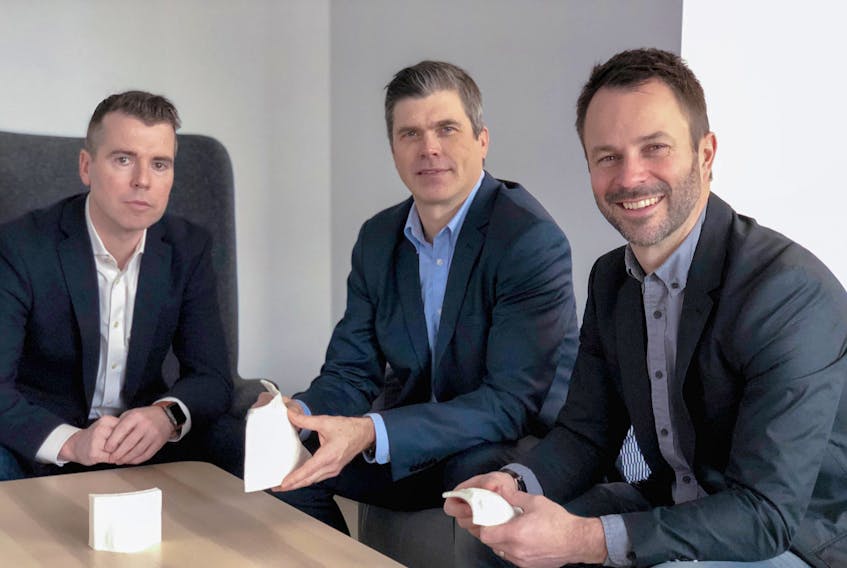In a five-part series, SaltWire Network delves into some of the hottest startups in Atlantic Canada. Each story focuses on three startups shaping an area of the entrepreneurial economy. Part five focuses on medtech startups.
PART 1: Three companies shaping Atlantic Canada's health and fitness startup scene
PART 2: Three companies shaping Atlantic Canada's food tech startup scene
PART 3: Three companies shaping Atlantic Canada's green tech startup scene
PART 4: Three companies shaping the East Coast fintech startup scene
Adaptiiv Medical Technologies
What’s the startup
Adaptiiv Medical Technologies has developed a state-of-the-art software platform used to design 3D printed medical accessories used in radiation oncology. Headquartered in Halifax, the startup’s software designs medical devices to help cancer patients receive more precise radiation treatments. The medical device or bolus — a tissue-like material that is personalized for a patient and printed on a 3D printer — is used to ensure the required dose of radiation therapy is delivered.
Why it’s needed
If a patient is receiving radiation therapy for cancer close to the skin’s surface, they often require a so-called bolus. “It’s a flimsy rubber-like layer that fits over a patient’s skin and allows the radiation to essentially build up dose,” Adaptiiv co-founder and CEO Peter Hickey says. The problem is the bolus doesn’t always fit perfectly. “Patients are all different shapes and sizes,” he says. "If there are air gaps between the bolus and the skin, it can cause radiation to underdose.” In other words, the success of a cancer patient’s treatment can hinge on an ill-fitting piece of rubbery material.
The inventor
The technology was born out of research by Dr. James Robar, Adaptiiv co-founder, Nova Scotia Health Authority chief of medical physics and director of Dalhousie University’s medical physics graduate program. “James is one of those phenomenally brilliant and curious individuals who has a deep background in radiation oncology,” Hickey says. “He built the original working prototype and filed the patents.”
How it works
Adaptiiv’s software saves clinicians hours of manual calculations. Health-care workers input data from the patient’s CT scans into the startup’s platform, which produces a personalized design. The bolus is then created on a 3D-printer. Hickey says it’s a cost-effective way to make a bolus that fits a patient. This ensures more accurate dosages of radiation therapy in the required areas while sparing healthy tissue.
Who’s on the team
Adaptiiv has three co-founders: James Robar, the inventor and medical expert, Peter Hickey, the expert in new commercial technology applications, and Alex Dunphy, the chief technology officer and a leader in big data analytics and software startups. On the board of directors is chairman Ali Riaz, a leader in multi-billion-dollar merger and acquisition transactions and the founder and CEO of Attivio. Board member Bruce Ross brings a background in the medical device industry. In all, the startup has 22 “extremely gifted people,” Hickey says. “We have a talented team with a real sense of purpose, and that’s helped us keep up a tremendous pace.”
The customer
After securing clearance from the U.S. Food and Drug Administration to market its 3D Bolus Software in 2018, Adaptiiv has rapidly grown its customer base. In Canada, it's focused on the provincial health authorities overseeing cancer treatment centres, while in the U.S. its market includes private cancer centres, university-affiliated hospitals like Indiana University Cancer Center, and government-run facilities like the Walter Reed Army Institute of Research. “We have a significant number of new client announcements that we expect to be rolling out in the coming months,” Hickey says, adding: “We just finished a raise, and that put us in very good shape.”
PolyUnity

What’s the startup
PolyUnity aims to make high-tech, low-cost 3D medical simulation models available to health-care workers and students around the world. The startup is developing a subscription-based online database of medical simulation models that can be used for medical training and education. The startup is also manufacturing the so-called task trainers — specialized simulators or models designed to help practice a specific skill — and shipping them from its St. John’s facility.
How it started
The company was founded by three Memorial University medical students. It started with a small kickstarter campaign, a basic 3D printer, and a desire to access top-quality, affordable medical models. The students eventually received university funding and launched Mun Med 3D, a research and innovation lab within the faculty of medicine. “We found the simulators on the market were pretty expensive,” says PolyUnity co-founder and CEO Michael Bartellas, a Newfoundland native currently completing a residency in head and neck surgery in Ottawa. “But we could create new models in house using 3D printers.”
The spin-off
While the Mun Med 3D lab continues to operate — securing funding to expand its rural 3D printing network — the three founders moved on to launch PolyUnity. “We were really proud of what we created, but we were ready to do our own thing,” Bartellas says, explaining that they wanted to scale it up commercially to reach more people. “Our vision is to reimagine access to health-care education.”
How it works
Bartellas says 3D medical simulations are now the gold standard in health-care training and education. “Before you do a procedure on a patient — in my case a surgical procedure — you would do a simulation on a 3D model,” he says. Health-care staff can download a model from PolyUnity to print the 3D medical simulation of a body part.
The customer
As 3D printers become more mainstream, Bartellas says PolyUnity’s potential customer base includes anybody interested in learning about the human body. This could include high school students, medical students or doctors. The startup is still finalizing its financial model but Bartellas says a large institution like a health authority or university will likely be able to subscribe to PolyUnity’s service. The startup also recently entered into a partnership with Eastern Health, the largest health organization in Newfoundland and Labrador.
BreatheSuite

What’s the startup
BreatheSuite has developed a small device that attaches to the top of an inhaler to monitor usage and collect data. “It’s like a little sensor that sits on top of your regular inhaler,” founder and CEO Brett Vokey says. The device tracks the time of the dose, and whether a patient is adhering to the prescribed dosage, as well as if they shake the inhaler, the orientation of the inhaler and the co-ordination between inhaling and pressing the canister. The inhaler add-on connects to a smartphone app, which provides feedback on usage and technique. The startup also has an online platform for health-care professionals to monitor a patient’s inhaler use and technique. The goal is to correct the improper use of inhalers, reduce wasted medication and improve patient outcomes.
The idea

Vokey was doing a work term at a hospital as a mechanical engineering student when he learned that incorrect inhaler use was a widespread issue. “It was a big problem,” he says. Although there was training available for patients, there wasn’t a device that provided data on usage and technique. “It’s really important to ensure that somebody is getting the medication to their lungs,” Vokey says. “But it's actually quite difficult to use them correctly.” He says the biggest issue is co-ordination: Users have to be inhaling prior to pressing the canister or a lot of the medication can end up hitting the back of their throat or tongue.
The development
Although Vokey launched the startup two years ago, he didn’t start to focus full time on BreatheSuite until his graduation last spring. “I decided that this was a problem that I was going to try to solve,” he says. “I spent several months iterating on some early design concepts.” He found a manufacturer in Ontario certified to make medical devices, and is now going through a regulatory approval process. The startup will also be performing clinical trials of the device in Canada and the U.S. to monitor its efficacy.
The impact
By ensuring patients are taking their medications correctly, BreatheSuite’s device has the potential to reduce hospital admissions related to respiratory conditions like asthma, Vokey says. It could also reduce the amount of wasted medication, reducing costs for patients and insurers.
“There’s a financial benefit for the insurer because less of that medication is being wasted,” Vokey says. “Right now people are taking three or four puffs when in fact they should only be taking one if they were taking it correctly.”
The customer
Vokey says the goal is to get insurance companies and health-care providers on board. To get there, he says the startup is focused on the regulatory approvals and clinical trials. BreathSuite raised a $550,000 round of equity financing last fall, and now has a team of nine and an advisory board. “We’ve only had a small number of people use the device so far, but the feedback has been really encouraging. The medical community as a whole is pretty excited about the device.”









